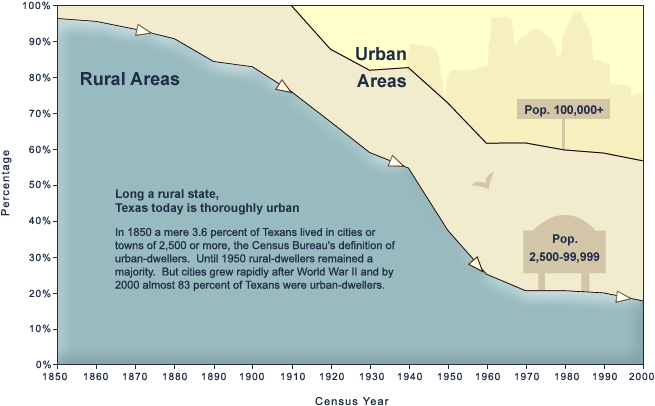| Urbanization in Texas, 1850-2000 |

|
| Source: U.S. Census (full source) |
Full Source:
Data is from U.S. Census Bureau publications. Definitions of urban and rural populations have changed over time. From 1790 to
1940 urban places were defined to include only incorporated places such as cities, towns, and boroughs of a minimum size, first
set at 8,000 in 1874, then lowered to 4,000 in 1880, and eventually in 1910 fixed at 2,500. Populations outside of urban areas
are treated as rural. Since 1950 the definition of urban places was broadened somewhat to include some unincorporated but densely
populated areas at the urban fringe of large cities or in units defined by the Census Bureau. Decennial data for the charts in
this feature comes from a variety of Census sources.
For 1850 to 1910, the Census count of the total population of Texas, the count for places of 2,500 or more population, and the rural population is from data aggregated to the state and county level compiled as part of Haines, Michael R., and the Inter-university Consortium for Political and Social Research. HISTORICAL, DEMOGRAPHIC, ECONOMIC, AND SOCIAL DATA: THE UNITED STATES, 1790-2000 [Computer file]. ICPSR02896-v2. Hamilton, NY: Colgate University/Ann Arbor: MI: Inter-university Consortium for Political and Social Research [producers], 2004. Through the 1910 Census no city in Texas reached 100,000 population so the count for incorporated places of 2,500 or more serves as a count for places of 2,500 to 99,999.
For 1920, total Texas population and population of places of 2,500 or more is from Haines, op cit. The population total for cities of 100,000 or more in Texas for 1920 is from 14th Census of the United States, State Compendium, Texas, U.S. Census Bureau, p.8, http://www2.census.gov/prod2/decennial/documents/06229686v38-43ch5.pdf (July 18, 2006).
For 1930-2000, population counts for rural areas, cities of 2,500 to 99,999 population, and cities of 100,000 population and over are calculated from the City Data Book files published in 1944 (using 1930 and 1940 census counts), 1952 (1950), 1962 (1960), 1972 (1970), 1983 (1980), 1994 (1990), and 2000. Data files from these publications are available as part of Haines, op cit. For 2000 see also "Table 4: Annual Estimates of the Population for Incorporated Places in Texas, Listed Alphabetically: April 1, 2000 to July 1, 2005 (SUB-EST2005-04-48)," U.S. Census Bureau. http://www.census.gov/popest/cities/tables/SUB-EST2005-04-48.xls (July 18, 2006).
Finally, several other resources are useful in exploring and summarizing urban and rural population counts. See, for example, "Selected Historical Decennial Census Urban and Rural Definitions and Data," U.S. Census. http://www.census.gov/population/www/censusdata/ur-def.html (July 18, 2006). See also "Table 1. Urban and Rural Population: 1900 to 1990," U.S. Census. http://www.census.gov/population/censusdata/urpop0090.txt (July 18, 2006) and "Table 4: Population: 1790 to 1990," U.S. Census. http://www.census.gov/population/censusdata/table-4.pdf (July 18, 2006).
For 1850 to 1910, the Census count of the total population of Texas, the count for places of 2,500 or more population, and the rural population is from data aggregated to the state and county level compiled as part of Haines, Michael R., and the Inter-university Consortium for Political and Social Research. HISTORICAL, DEMOGRAPHIC, ECONOMIC, AND SOCIAL DATA: THE UNITED STATES, 1790-2000 [Computer file]. ICPSR02896-v2. Hamilton, NY: Colgate University/Ann Arbor: MI: Inter-university Consortium for Political and Social Research [producers], 2004. Through the 1910 Census no city in Texas reached 100,000 population so the count for incorporated places of 2,500 or more serves as a count for places of 2,500 to 99,999.
For 1920, total Texas population and population of places of 2,500 or more is from Haines, op cit. The population total for cities of 100,000 or more in Texas for 1920 is from 14th Census of the United States, State Compendium, Texas, U.S. Census Bureau, p.8, http://www2.census.gov/prod2/decennial/documents/06229686v38-43ch5.pdf (July 18, 2006).
For 1930-2000, population counts for rural areas, cities of 2,500 to 99,999 population, and cities of 100,000 population and over are calculated from the City Data Book files published in 1944 (using 1930 and 1940 census counts), 1952 (1950), 1962 (1960), 1972 (1970), 1983 (1980), 1994 (1990), and 2000. Data files from these publications are available as part of Haines, op cit. For 2000 see also "Table 4: Annual Estimates of the Population for Incorporated Places in Texas, Listed Alphabetically: April 1, 2000 to July 1, 2005 (SUB-EST2005-04-48)," U.S. Census Bureau. http://www.census.gov/popest/cities/tables/SUB-EST2005-04-48.xls (July 18, 2006).
Finally, several other resources are useful in exploring and summarizing urban and rural population counts. See, for example, "Selected Historical Decennial Census Urban and Rural Definitions and Data," U.S. Census. http://www.census.gov/population/www/censusdata/ur-def.html (July 18, 2006). See also "Table 1. Urban and Rural Population: 1900 to 1990," U.S. Census. http://www.census.gov/population/censusdata/urpop0090.txt (July 18, 2006) and "Table 4: Population: 1790 to 1990," U.S. Census. http://www.census.gov/population/censusdata/table-4.pdf (July 18, 2006).